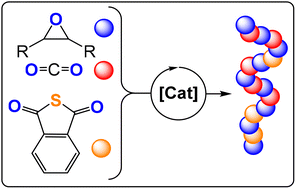Ring-opening terpolymerisation of phthalic thioanhydride with carbon dioxide and epoxides†
Abstract
In seeking to expand the portfolio of accessible polymer structures from CO2 waste, we report the ring-opening terpolymerisation (ROTERP) of phthalic thioanhydride with CO2 and epoxides, forming statistical poly(ester-thioester-carbonates) by employing heterobimetallic catalysts. Both metal choice and ligand chemistry modulate the amount of CO2 incorporated into the polymer microstructure. Terpolymerisation occurs when maintaining polymerisation rates of the faster parent ring-opening copolymerisation and this finding led us to develop the formation of CO2-derived terpolymers with butylene oxide at low CO2 pressure under bicomponent catalysis. Tetrapolymerisation with added phthalic anhydride leads to the preferential polymerisation of phthalic anhydride before the polymerisation of sulfur derivatives with CO2 and epoxides. Finally, we show that the presence of sulfur-containing thioester links leads to polymers with degradability benefits compared to those from all-oxygen derivatives.

- This article is part of the themed collection: Polymer Chemistry Emerging Investigators Series


 Please wait while we load your content...
Please wait while we load your content...